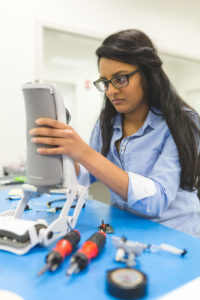Medical product design verification and validation activities (called “Phase 3” and “Phase 4” at GCMI) typically come after a design phase (called “Phase 2” at GCMI). At the completion of the design phase, a product will have well-defined design inputs, plus fully described design features and manufacturing methods. Design verification and validation then takes this design output (product) and ensures that it meets all engineering requirements and user needs, respectively.
Design verification ensures that the team has made the product “right” – according to the engineering requirements. And design validation ensures that you have made the “right” product – according to the customer’s needs.
What are the goals of verification and validation?
Design verification and validation (DV&V) is often completed through physical testing, but can also include other methods such as inspections, review of specifications or analysis of materials. A typical process for DV&V starts with generating a testing and analysis plan, listing all design inputs and identifying how they will be verified and validated. The project team then documents the detailed protocol for completing each test or analysis, including measurable acceptance criteria. After the evaluations are completed, all data and conclusions are recorded in formal reports. All of these documents are catalogued in the device’s Design History File.
Regulatory bodies and auditors require a well-documented and completed verification and validation plan, test protocols and results. This critical set of documentation serves as the project team’s evidence to the regulatory body that the product is safe and effective. DV&V reports are often provided as written or in a summary form directly to the regulatory agency.
A regulator will review the results for questions such as:
- For medical electrical equipment, has the product safety been shown in accordance with international standards like IEC 60601-1?
- For a product that touches a patient, has it passed all applicable biological safety testing?
- Has the product performance been demonstrated, even in a worst-case scenario?
What are the design verification activities?

Photo by Mike Glatzer Photography #mikeglatzerphotos
Design verification ensures that the product’s design outputs meet identified engineering requirements. There are various kinds of test methods that can be applied based on what aspect of the device is under evaluation. Physical testing could include mechanical or electrical benchtop tests, bench top tests using biological tissues, preclinical evaluations, etc.
What are the design validation activities?
Design validation ensures the product’s design output meets identified user needs. User needs can be validated in different ways including usability studies, short or long preclinical studies, and clinical trials. These typically evaluate the user’s interaction with the device, or its comprehensive functional performance. Prior to approval to begin a clinical trial, all other testing must be completed and submitted to a regulatory body.
What happens at the end of DV&V?
At the end of successful verification and validation, a medical product is ready for regulatory submission or marketing, depending on the product’s regulatory classification. The manufacturing transfer phase typically follows, ensuring that high quality products can be made at sufficient product volumes.
Why GCMI for verification and validation?
GCMI’s broad experience in verification and validation spans from developing unique test methods to documenting protocols and reports in a manner compliant with regulatory requirements. We are proficient in determining and conducting the best test methods for each situation. Our goal is to help our clients get it right the first time. GCMI serves as your comprehensive project planning, research and development team, taking an integrated view of product design and manufacturing process development. Our phased approach gives promising technologies the best chance to achieve commercialization in a cost efficient manner.
GCMI also has an industry leading preclinical contract research organization (CRO) “in house.” Our CRO is an AAALAC accredited facility that conducts feasibility, proof of concept, safety, and GLP medical product testing for studies in any therapeutic area and in small and large models. Since January 2012, we have archived more than 50 GLP studies for leading medical product manufacturers of which more than 25 products have received regulatory approvals. Our preclinical team is comprised of seasoned preclinical program directors and managers with the bioengineering and veterinary expertise that lends them to a high level of understanding your science.
If you would like to take a deeper dive into DV&V, or to get the conversation started with a member of our medtech design and development team, please use the contact form below. We will then arrange to put you in touch with the member of the team most appropriate to address your needs.
